There were some families and some areas that the Stanly/Montgomery/Rowan County Melton's clung to. The families were Kirk, Boysworth, Forrest, Christian and Solomon. The areas were Swift Island, Albemarle and Gold Hill, Rowan County. The thing these 3 areas had in common: Gold. "Albemarle" was more acurately "New London" in modern terms, a small town just few miles north of Albemarle, and the other area was near the old Swift Island ferry, not far from the modern 24/27 bridge.
The following information is just a small bit of information that I was able to find about these areas and the Melton's family's involvement with it.
Gold Fields along the Southern Railway
![]() This pamphlet, published in 1897, was a publicity attempt to draw people to the area and business to the Southern Railway. It was called:
This pamphlet, published in 1897, was a publicity attempt to draw people to the area and business to the Southern Railway. It was called:
![]()
By M.V. Richards, Land and Industrial Agent, Southern Railway. The caption under the picture of the rock says:
Sam Christian's mine was located near the Swift Island/PeeDee area of Montgomery County, close to present day Mount Gilead, the Melton's settled on the Stanly County side of Swift Island.
![]()
![gf019_mod.jpg (494339 bytes)]()
![]()
Authority for organizing this Lodge was by Dispensation issued Aug. 8, 1850. It was issued in Raleigh to L. Blackmer, P. M. of Palestine Lodge No. 120 in Gold Hill; to organize a new lodge "at Zion in Montgomery County". It took two weeks for the mail to bring the document from Raleigh to Gold Hill.
The first meeting was held in Lawrenceville on August 16, 1850 with L. Blackmer as W. M.; assisted by Brethren J. M. Coffin and Arch Honeycutt of Palestine Lodge No. 120. Two petitions were received and both Preston Wooley and George Makepeace received the first two degrees that day. The organizers stayed overnight in Lawrenceville and the following day, the first two candidates received the M. M. Degree. In addition, that second meeting received two petitions from J. H. Montgomery, S. H. Christian, R. I. Mebane, all of which were elected.![]()
![]()
The following information is just a small bit of information that I was able to find about these areas and the Melton's family's involvement with it.
Gold Fields along the Southern Railway
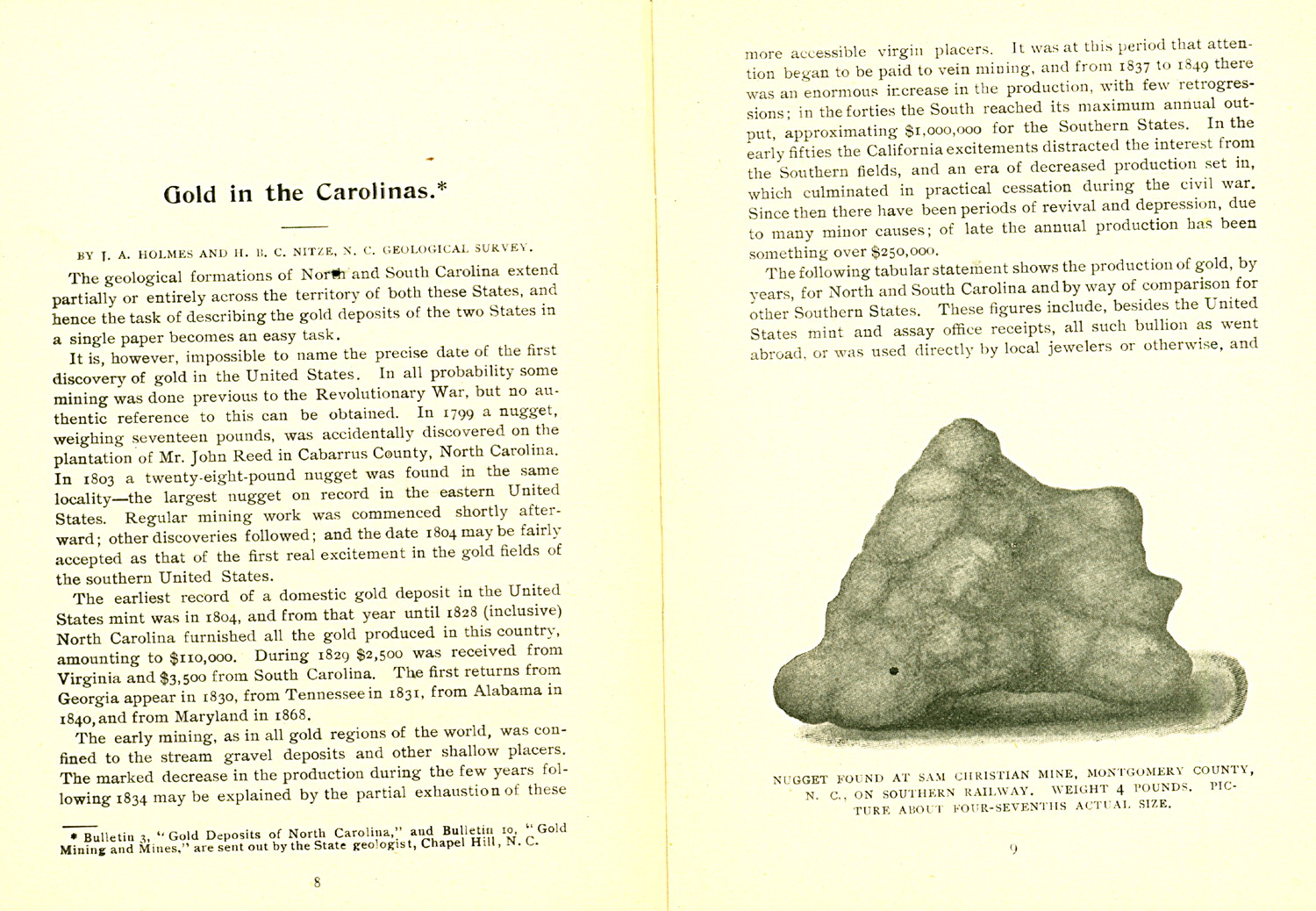 This pamphlet, published in 1897, was a publicity attempt to draw people to the area and business to the Southern Railway. It was called:
This pamphlet, published in 1897, was a publicity attempt to draw people to the area and business to the Southern Railway. It was called: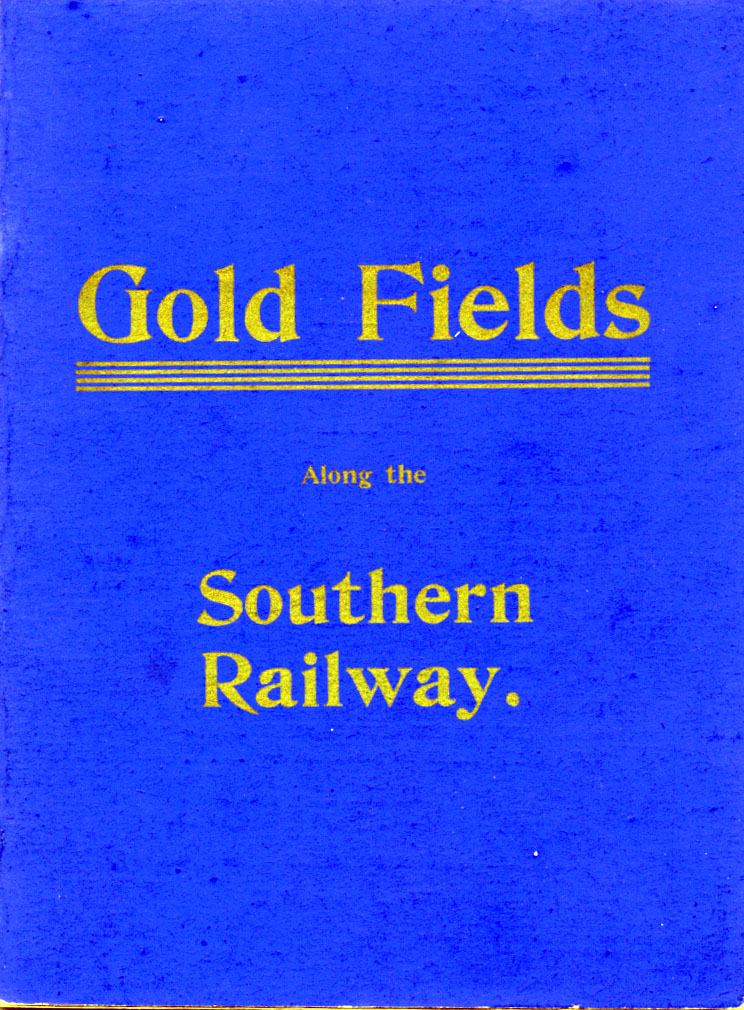
By M.V. Richards, Land and Industrial Agent, Southern Railway. The caption under the picture of the rock says:
("Nugget found at Sam Christian mine, Montgomery County, N.C., on Southern Railway. Weight 4 pounds. Picture about four-sevenths actual size.") |
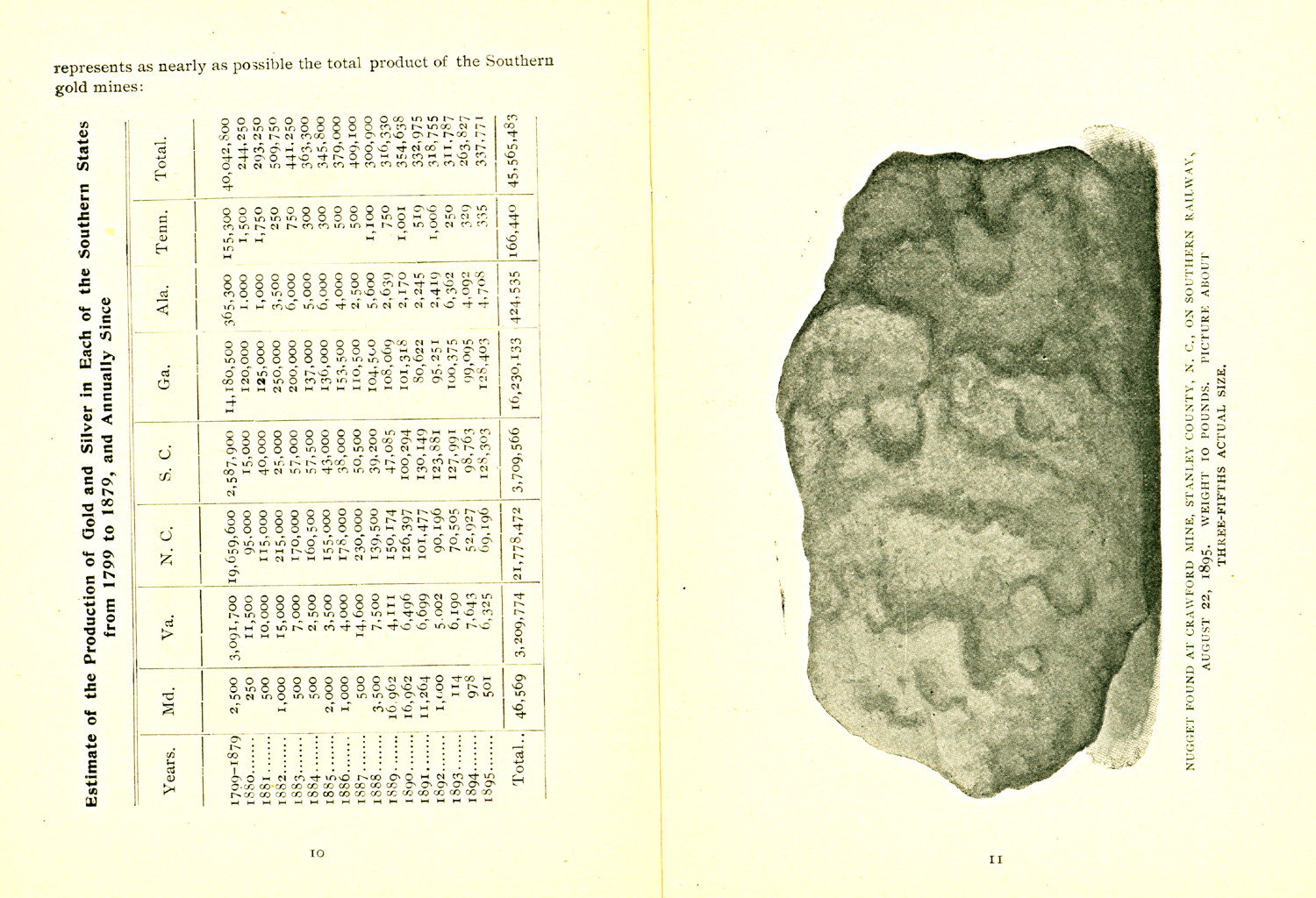
"Nugget found at Crawford Mine, Stanley County, N.C., on Southern Railway, August 22, 1985. Weight 10 pounds. Picture about three-fifths actual size." |
In the 1820's, all of the gold being produced in the US was coming from North Carolina. Of course, it was soon followed by Tennesee, Virginia, South Carolina, Georgia and Maryland.
That nugget found in the creek in Cabarrus County, near the Stanly County line, started a fire that was dimmed in 1849, but smoldered throughout the 1800's. The pamphlet went on to boast the quality and quantity of gold found in Stanly, Rowan and Cabarrus counties.
The best known and most extensively worked mining district in North Carolina is that at Gold Hill, at the junction of Rowan, Stanly and Cabarrus Counties. The country rock is chloritic and argillaceous schist, with the usual northeast by southwest strike, and dipping steeply to the northwest. For a distance of 1 1/2 miles along the strike and for a width of about 1,,200 yards the country rock is more or less impregnated with gold bearing pyrite, the pyrite being concentrated into more limited belts, in which are numerous lenticlar veins and small stringers of gold-bearing quartz. Among the better defined of these veins are the Randolph, Barnhardt, Honeycut, Standard, Trautman and McMackin. The first of these has been worked to a depth of 750 feet. |
The article continued:
It is stated that recent experiments at the Russell mine in Montgomery County, N.C., have shown that treatment by the cyanide process will cost from 90 cents to $1 per ton, on a scale of 100 tons per day, with an extraction of 85 to 90 per cent. |
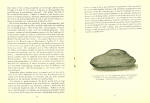
"Nugget found at Sam Christian Mine, Montgomery County, N.C., on Southern Railway. Weight 2 pounds. Picture one-half actual size. |
This site:
Gives the following information on the Sam Christian mine:
Sam Christian Mine - from Wadeville, west to within 3 miles of junctions of Routes 24 and 27, the Sam Christian Mine produced native gold (notable for large nuggets). Sam Christian Mine produced gold in placers, very large nuggets. This mine has gained something of a reputation for large and fine nuggets. The gold is found in old "channels", in gravel of a thickness of one to 3 feet and deeply covered with soil. The gold is rarely found in dust, but generally in nuggets of from 5 Dwts. to 1000 Dwts. The tract contains 1286 acres and has been worked in two places: Dry Hollow and the old Sam Christian Cut. Other channels are also known. The mine is 190 feet above the adjacent watercourses. The Yadkin River at Swift Island Ford are 3 miles away. The Sam Christian mine, located near Swift Island about 8 miles south of Morrowtock in the area of Shelter Mt., is mentioned in the following account of Mt. Gilead history: 1867-68 Christian mine operated by Sam Christian. 1872-Not in operation. 1890-Sam Christian mine in charge of a London company. 1896-Sam Christian mine owned by J.A. McAuley of Mt. Gilead. Gold was reportedly mined an a very small scale as early as 1785 near crossroads and Pekin in the lower section of Montgomery County, though no notes have been located to verify this fact. Located 4.5 miles west of Wadeville, the Sam Christian Mine was worked intermittently for several years and yielded many nuggets. This mine has been owned by many different men. It was operated for a time by hydraulic methods with water pumped from the nearby Yadkin River. The deposits of this mine consist of alluvium in former stream channels.
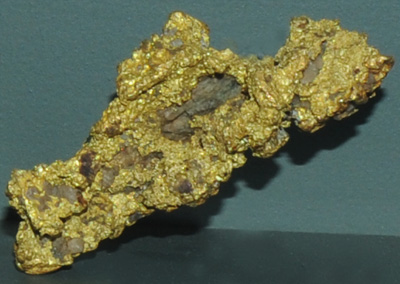 |
| Gold sample from the Sam Christian mine |
Who was Samuel Christian and what connections did he have with the Melton family?
Records indicate he was born in the early 1800's and died in 1864. He was the son of Rev. John Christian, and with the establishment of his mine, became one of the richest men in Montgomery County. He served as the postmaster of Lawrenceville, which was the county seat of Montgomery/Stanly Counties for a time before the they split into two counties.
| Saml H Christian | |
| Post Office Location: | Lawrenceville, Montgomery, North Carolina |
|---|---|
| Appointment Date: | 12 Oct 1833 |
| Volume #: | 16 |
| Volume Year Range: | 1844-1856 |
| U.S., Appointments of U. S. Postmasters, 1832-1971SCHOOLS, DIRECTORIES & CHURCH HISTORIES |
|
He owned a large amount of land and property and records indicate he was planning on opening cotton mills with technology ahead of it's time. Montgomery county documents place him as owning "machinery used in factories for spinning yarn" and indicated that the machinery would be driven by water power, channeled no doubt, from the Yadkin River, a resource he used in his highly destructive environmentally gold-mining operations. Christian owned a large number of slaves and at the end of the century, a large population of African-Americans with the surname "Christian" lived in the PeeDee/Swift Island section of Montgomery County.
In addition :
Personnel of the Convention of 1861, Issues 1-3
By John Gilchrist McCormickGives the following account of Samuel H. Christian:
"S. H. Christian of Montgomery, was born at Lawrenceville, Montgomery County, May 20, 1805. The Christians were of English ancestry and came to North Carolina from Virginia, settling on the fertile bottom-land of the Pee Dee River in the above county. When a very small boy, he had the misfortune to be injured in such a manner to make him a cripple for life. He recieved his education at the neighborhood schools and at an early age embarked in the merchantile business. He soon united farming with it and was very successful in both. He also added a large flouring mill to his other interests. He represented his county in the State Senate in 1854 and '56. He was strongly opposed to secession. He was appointed to the Confederate Congress in 1863, but died, March 2 in 1864, before taking his seat."
In the book "North Carolina Reports: Cases Argued and Determined in the Supreme Court" Vol. 72, it states, "Upon the death of S. H. Christian, upon failure of his personal estate, his administrators instituted proceedings in the Superior Court of Montgomery County to sell the real estate for the payment of debts..... Fall Term 1867..decree was made authorizing the sale of all lands, mills, and other real estate. Among the tracts was the "mill tract" in Montgomery and the "Davis Tract" in Stanly. These tracts were described fully, but neither in the petition, nor in the decree of sale, is there anything said about the ferry.... Spring 1868...'the mill on the Montgomery side, and factory with outhouses and other appurtenances, was bid off by Nathaniel Knight....sale of the Stanly land....Feb 18, 1869...by J. G. Christian...."All that tract or parcel of land lying and being in the county of Stanly, and described as follows: lying on the west side of Pee Dee river; adjoining the land of William Davis and others, bounded as follows, viz: Beginning at a white oak on the bank of the river, just below the mill, and running thence due west, with Heathcock's and Heron's mill tract, (formerly S. H. Christian's), 29 chains to a stone heap in the field, .....(etc).....purchased for the benefit of the Swift Island Manufacturing Company...the deed to D. N. Patterson's was for the tract lying between the widow's dower, Robinson's line, and the river, containing about 200 acres containing the mill, factory and appurtenances, operatives houses, ferry and fishery. .....decree.....That the ferry at Swift Island was not mentioned in the original record....The plaintiffs asked the court to charge the jury that by their purchase of the "William Davis" tract, on the Stanly side of the river, they required the right to one-half of the ferry as appendant and appurtenant to that tract, they being owners to the thread of the stream. ............The ferry was established by the Plank Road Company under the authority of an act 16th Feb 1859, and was used in connection with the plank road, and as a part thereof. It is set out as a fact in the case:"The Plank Road having fallen into decay, and being discontinued as a turnpike, one Christian, the owner of the land on both sides of the river, claimed the franchise of the ferry, and kept it up until his death....according to the facts before us, the Plank Road is still in existence, and is the owner of this ferry, and above all, there is no evidence that Christian ever acquired title to the ferry, as an appurtenant to the land he owned on the Stanly County side, or the Montgomery side, or either or both....was not kept by him as a franchise 'en grosse'
This legal document paints a picture of what a wealth of activity and productivity was going on along the river at the Swift Island area at this time. I will never cross the bridge between Stanly and Montgomery feeling the same way again. In my mind will be a landscape populated with water-powered mills instead of river homes, a ferry instead of a bridge and a plank road instead of a tar and gravel one.
Samuel H. Christian and the history of this area is also mentioned in an article at this link:
Authority for organizing this Lodge was by Dispensation issued Aug. 8, 1850. It was issued in Raleigh to L. Blackmer, P. M. of Palestine Lodge No. 120 in Gold Hill; to organize a new lodge "at Zion in Montgomery County". It took two weeks for the mail to bring the document from Raleigh to Gold Hill.
The first meeting was held in Lawrenceville on August 16, 1850 with L. Blackmer as W. M.; assisted by Brethren J. M. Coffin and Arch Honeycutt of Palestine Lodge No. 120. Two petitions were received and both Preston Wooley and George Makepeace received the first two degrees that day. The organizers stayed overnight in Lawrenceville and the following day, the first two candidates received the M. M. Degree. In addition, that second meeting received two petitions from J. H. Montgomery, S. H. Christian, R. I. Mebane, all of which were elected.
The Morganton-Fayetteville Turnpike ran from Morganton eastward through Salisbury and southward through Gold Hill, Lawrenceville, Zion, Pee Dee, and Providence toward Fayetteville. Providence became Mt. Gilead (pictures A and B)in the early 1800’s and the name of the incorporated own in later years. In 1986, highways would be US 52 south of Salisbury and NC 73 east of Albemarle through Mt. Gilead. Zion Methodist Church was established in 1786 and was the center of a growing community in 1850, followed by decline during and after the Civil War. Zion and Blackmer both have gone through difficult times and periods of suspension, but Zion celebrated its 200th anniversary on the 22nd of June 1986.
Obviously, the organizers had traveled from Gold Hill, crossed the river at the Swift Island ferry, and met in the town of Lawrenceville. Lawrenceville was a formally laid-out town in rectangular shape with about 50-plus houses, and the County Court House at the center. The courthouse burned in 1836 and the town declined thereafter. ( 4 )
At the Court House in Troy, the Montgomery County Register of Deeds, Book 16, Pages 366/7 shows an entry dated November 25, 1850. It shows that Col. Edmond Deberry (1787-1859) sold a lot "on the east side of the Turnpike --- at Zion." Buyer was Trustees of Blackmer Lodge No. 127 jointly the trustees of "Sons of Temperance"; for the purpose of erecting and "occupying a meeting hall."
At the Court House in Troy, the Montgomery County Register of Deeds, Book 16, Pages 366/7 shows an entry dated November 25, 1850. It shows that Col. Edmond Deberry (1787-1859) sold a lot "on the east side of the Turnpike --- at Zion." Buyer was Trustees of Blackmer Lodge No. 127 jointly the trustees of "Sons of Temperance"; for the purpose of erecting and "occupying a meeting hall."
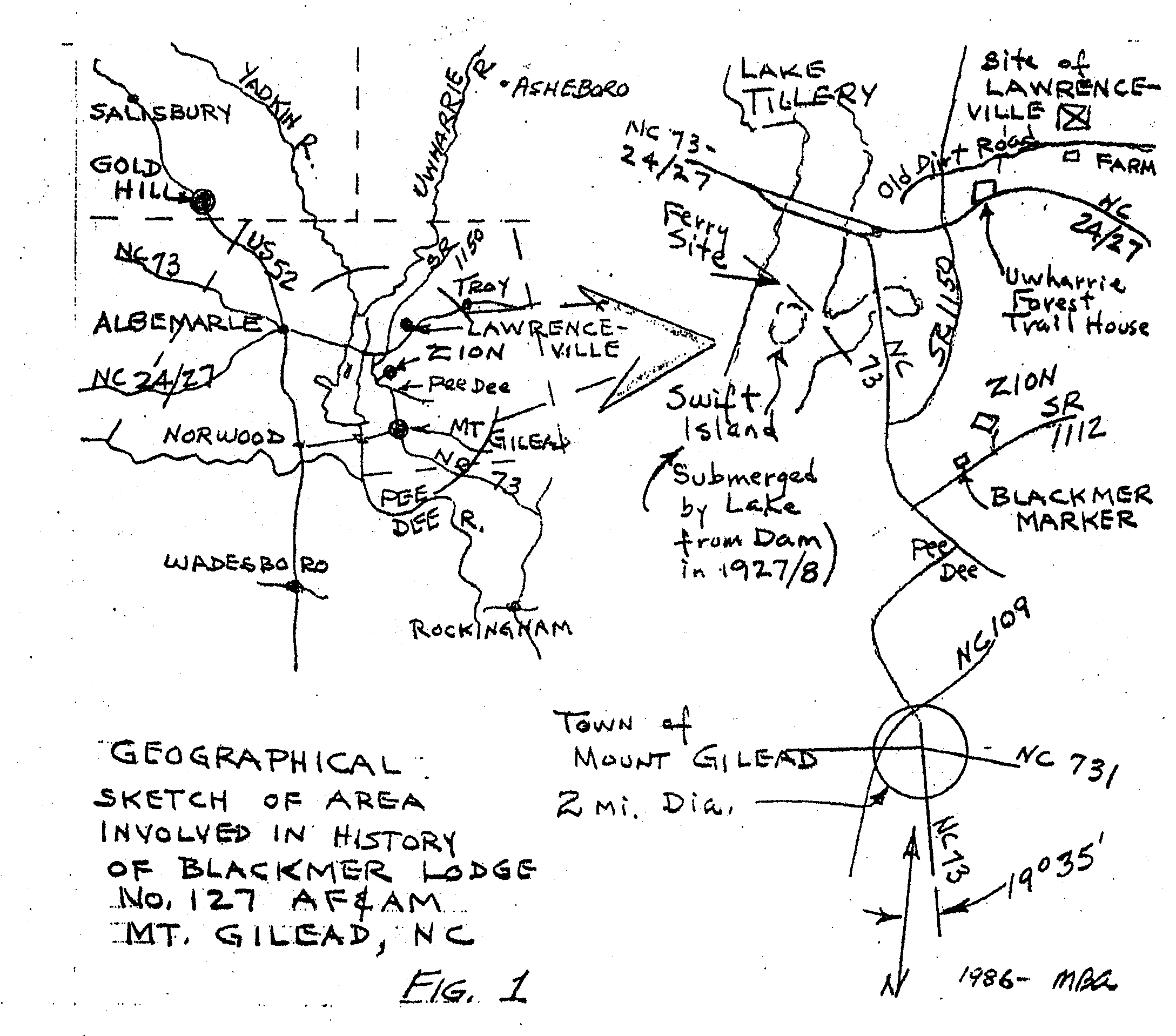
Before the series of dams along the Yadkin/Pee Dee river changed the landscape forever, there existed an actual island in the river. Being situated in the Uwharries and not far from the current Morrow Mountain State Park, the small mountains and hill rose gradually on either side of the river causing high banks and a rushing stream around either side of the island. This is where "Swift Island" got its name. Currently, a nearby gas station bears the name "Swift Island" and one day, a child of mine asked where the name came from, as the Island must have been so swift that it got away.
This history on the S. H. Christian mine, the location of Swift Island and gold mining in the area was to lead to this one find of information from the Carolina Watchman, Salisbury, NC.
Sept 17, 1858 issue
"Robert Melton, and a negro man belonging to Thomas Lilly, accidentally crushed to death while tunneling in a pit, recently, at Christian's Gold Mine in Montgomery County. "
Thomas Lilly hired out his help in the mines and lived to see another day. Robert Melton was a fatherless young man.
| Name: | Thomas Lilly | ||||||||||||||
|---|---|---|---|---|---|---|---|---|---|---|---|---|---|---|---|
| Age in 1870: | 52 | ||||||||||||||
| Birth Year: | abt 1818 | ||||||||||||||
| Birthplace: | North Carolina | ||||||||||||||
| Home in 1870: | Mount Gilead, Montgomery,North Carolina | ||||||||||||||
| Race: | White | ||||||||||||||
| Gender: | Male | ||||||||||||||
| Post Office: | Mount Gilead | ||||||||||||||
| Value of real estate: | View Image | ||||||||||||||
| Household Members: |
|
Other Melton's who lost their lives in the search for gold were Harris Melton and John Melton, Jr., after moving to Gold Hill in Rowan County. John made enough money for his widow, Nancy Boysworth Melton to purchase a hotel from Mr. Green L. Wren, of Virginia and Warren Counties, N. C.
